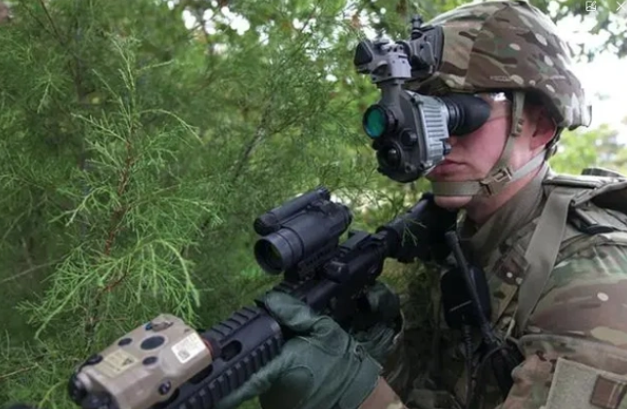Definition and Features
Military night vision goggles are a type of night vision equipment designed specifically for military use, which allows users to see targets clearly in low-light or no-light environments. Its key component is the image intensifier tube, which can amplify weak light signals, convert photons into electrons, and after being processed by a series of electronic devices, convert electrons back into photons, presenting an enhanced visual image in the eyepiece.
It has a high magnification function, allowing users to observe the details of targets at a longer distance. For example, some advanced military night vision goggles can bring the target closer by several times or even dozens of times, making it convenient for soldiers to conduct reconnaissance and surveillance. And it has a sturdy and durable shell, usually made of high-strength engineering plastics, metal alloys and other materials, which can withstand the harsh conditions such as collisions, falls, sand and dust, and flooding that may be encountered in military operations.
It has good concealment, for example, the infrared light it emits (if any) is not easily detected by the enemy, and the optical design minimizes reflections to avoid exposing the user's position.

Main types
Low-light night vision goggles:
This type of night vision goggles mainly uses weak natural light at night, such as moonlight and starlight. Its core is the low-light image intensifier, and the level of the image intensifier (such as first, second, third, etc.) determines its performance. The first-generation low-light night vision goggles have relatively weak performance, low image resolution and brightness, while the third-generation low-light night vision goggles have strong performance and can provide clear images in extremely dark environments.
Usually used in environments with a certain amount of natural light, such as patrolling in open areas at night, observing the dynamics of personnel and equipment in enemy positions in a battlefield environment illuminated by moonlight, and other scenes.
Infrared night vision goggles:
Include active infrared night vision goggles and passive infrared night vision goggles (thermal imaging night vision goggles). Active infrared night vision goggles have their own infrared light source, which forms images by emitting infrared rays and receiving reflected infrared rays. Passive infrared night vision goggles detect the target's own thermal radiation to form images, and do not actively emit infrared rays.
Active infrared night vision goggles are suitable for scenes where there is no natural light source and active detection of targets is required, such as searching for enemies in completely dark buildings, but because they emit infrared rays themselves, there is a risk of being discovered by enemy detection equipment. Passive infrared night vision goggles are widely used in military reconnaissance, special operations and other scenes. For example, they can be used to detect enemies hidden in the grass, woods or bunkers, because the heat signal of the human body is different from the surrounding environment and can be easily identified.
Precautions for use
Light conditions: When using low-light night vision goggles, make full use of the weak light in the environment. If the ambient light is too dark, you can consider using an infrared auxiliary light source (for night vision goggles with this function), but be careful to control the intensity of the light source and the frequency of use to avoid exposure. When using passive infrared night vision goggles, be aware that the difference in heat signals of different objects may be affected by environmental factors (such as temperature, humidity, etc.).
Operating tips: It is important to hold and stabilize the night vision goggles correctly, because shaking will affect the observation effect. You can use both hands to hold or use auxiliary equipment such as a tripod. When adjusting the focal length, operate accurately according to the target distance to obtain a clear image.
Maintenance: Clean the lens regularly, use special lens cleaning tools and cleaning fluid to avoid scratching the lens. Keep the inside of the night vision goggles dry to prevent moisture from entering and affecting the performance of electronic components. If not used for a long time, remove the battery and store the night vision goggles properly.


